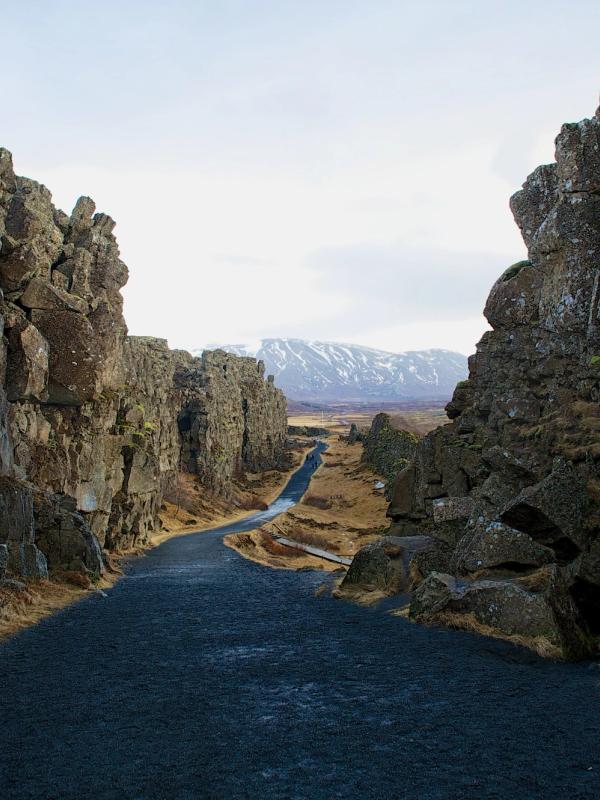
The Almannagjá Gorge in Iceland: Walking Between Continents
At Almannagjá Gorge in Iceland, you can stand between two continents at once. This rift isn't just a pretty landscape – it's where the North American and Eurasian tectonic plates pull apart right in front of you.
The gorge sits in Þingvellir National Park, one of Iceland's most important natural and historical sites. It's where Iceland's first parliament was formed over 1,000 years ago and where the country declared independence in 1944.
If you're into geology, history, or simply want some great photos, Almannagjá should be on your Iceland trip plan. Here's everything you need to know about this unique place.
Key takeaways:
- Almannagjá is a geological site where two continental plates visibly separate
- The site hosted the world's first parliament in 930 AD and is now a UNESCO World Heritage Site
- You can hike, dive, and explore historic sites all in one location
- It's easy to reach as part of Iceland's popular Golden Circle route
- Entry is free (but parking costs 1,000 ISK)
What's the Almannagjá Gorge?
Almannagjá is the largest fissure in Þingvellir Rift Valley. It forms part of the Mid-Atlantic Ridge, the boundary where the North American and Eurasian tectonic plates meet and slowly drift apart.
The gorge stretches approximately 8 kilometers through Þingvellir National Park, with walls that reach up to 40 meters in height in some places. What makes it special is that you can actually walk between these continental plates, something you can do in very few places on Earth.
The name "Almannagjá" translates roughly to "Everyone's Rift" in Icelandic, showing its importance to the entire nation.
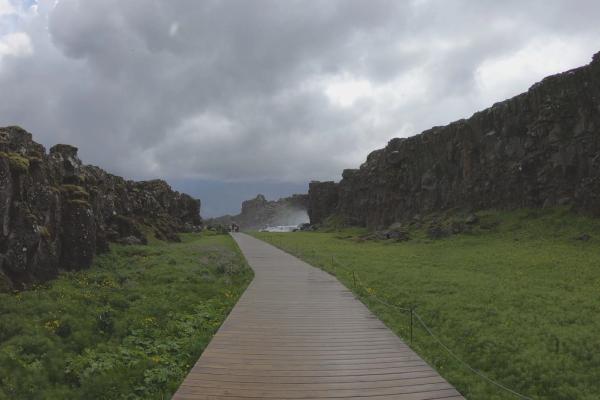
How was it formed?
Almannagjá began millions of years ago and continues forming today. The gorge exists because Iceland sits directly on the Mid-Atlantic Ridge, where two massive tectonic plates pull away from each other at about 2 centimeters per year.
As these plates move apart, the land between them sinks, creating the rift valley. Earthquakes cause chunks of land to drop suddenly, forming the cliff edges you see today. One strong earthquake in the past caused a section of the North American plate to break free, creating the main wall of Almannagjá.
What makes this process visible in Iceland (unlike most of the Mid-Atlantic Ridge, which lies underwater) is that Iceland also sits on a volcanic hotspot. As the plates pull apart, magma rises to fill the gaps, creating new land and keeping parts of the ridge above sea level.
The result is a landscape that's always, though slowly, changing. The gorge you see today is wider than it was when Iceland's first settlers arrived, and it will continue to widen throughout our lifetimes.
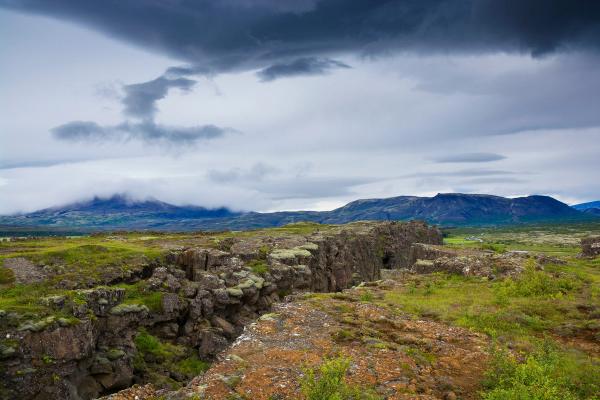
Historical and Cultural Significance
While the geology alone makes Almannagjá worth visiting, its historical importance is equally notable. In 930 AD, Viking settlers chose this spot to establish the Alþingi (Althing), one of the world's oldest parliamentary assemblies.
The natural amphitheater created by the gorge's walls provided good acoustics for public speaking. At the Law Rock (Lögberg), the law speaker would recite one-third of the law code each year from memory and make important announcements to the gathered assembly.
For centuries, chieftains and farmers gathered here each summer to settle disputes, create laws, arrange marriages, and trade goods. The site became the heart of the Icelandic Commonwealth period, helping form Iceland's identity as a nation.
The gorge witnessed key moments in Icelandic history:
- In the year 1000, Iceland adopted Christianity at the Alþingi after intense debate
- Criminals faced judgment here, with some women convicted of serious crimes, who were then drowned in the "Drowning Pool."
- Famous figures from the Icelandic sagas, like Snorri Sturluson, attended assemblies here
- On June 17, 1944, thousands gathered at Þingvellir to celebrate Iceland's complete independence from Denmark.
This rich history led UNESCO to declare Þingvellir a World Heritage Site in 2004, recognizing its unique combination of cultural and natural significance.
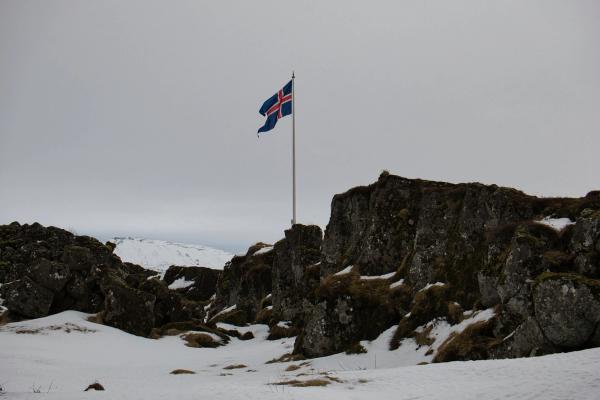
Location & How to Get There
Almannagjá Gorge is located in southwestern Iceland, about 30 miles (48 km) northeast of Reykjavík. It forms the western boundary of Þingvellir National Park and sits along the popular Golden Circle tourist route.
Getting to Almannagjá is simple:
By car: From Reykjavík, take Ring Road (Route 1) east, then turn onto Route 36 toward Þingvellir. The drive takes about 45 minutes. Several parking lots are available near the visitor center and at key viewing points. Parking costs 1,000 ISK (about $7 USD).
By bus: Regular buses run from Reykjavík to Þingvellir during the summer months. The trip takes around an hour.
With a tour: Many companies offer Golden Circle day tours from Reykjavík that include Þingvellir, Geysir, and Gullfoss Waterfall. These typically cost between 8,000 and 15,000 ISK ($60-110 USD), depending on the group size and included activities.
Once you arrive at Þingvellir, marked paths lead to the main viewpoints over Almannagjá. The most popular entry point is near the visitor center, where a wooden walkway provides easy access into the gorge.
Exploring the Almannagjá Gorge & Things to Do
Almannagjá offers plenty to see and do, whether you're spending a few hours or a full day. Here are the highlights:
Hiking the Almannagjá Trail
The main walking path through Almannagjá stretches approximately 2.5 miles (4 km) round-trip, if you walk all the way to Öxarárfoss waterfall and back. The trail is mostly flat and well-maintained, with boardwalks over uneven or wet sections, making it accessible for most visitors.
As you walk, you'll pass between the cliff face of the North American plate on one side and the lower rubble of the Eurasian plate on the other. Information boards along the way explain the geology and history of key sites.
The hike offers plenty of photo opportunities, especially where the path narrows and the walls tower overhead. Look for small caves and fissures in the rock face.
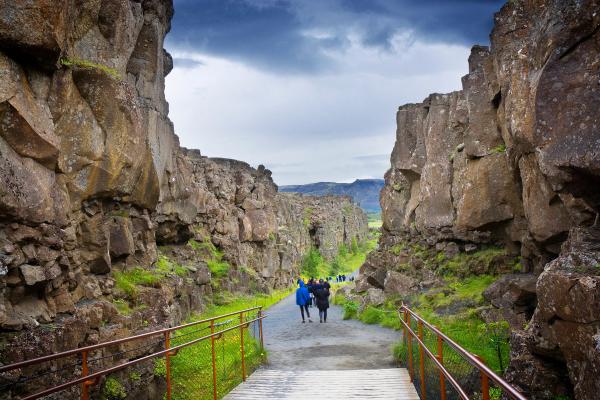
Öxarárfoss Waterfall
About 1 kilometer into the gorge, you'll reach Öxarárfoss, a waterfall that drops 20 meters down the face of Almannagjá. The waterfall is actually man-made: Vikings diverted the Öxará River over the cliff edge to provide water for parliamentary assemblies.
In winter, the waterfall sometimes freezes partially or completely, creating ice formations. Year-round, the combination of falling water, black basalt, and green moss makes for good photos.
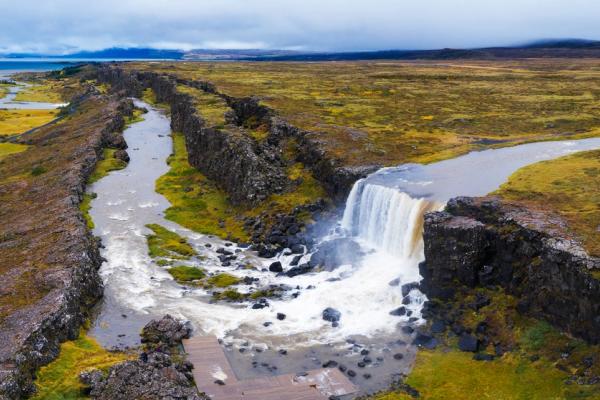
Silfra Fissure
Near the northern end of Almannagjá lies Silfra, a water-filled fissure that offers a unique diving and snorkeling experience. Here, you can swim between the North American and Eurasian tectonic plates in water so clear that the visibility exceeds 100 meters.
The water in Silfra is glacial meltwater that has been filtered through porous lava rock for 30 to 100 years, making it exceptionally pure. Its temperature stays between 2-4°C (35-39°F) year-round, so you'll need a drysuit even in summer.
Several companies offer guided snorkeling and diving tours of Silfra, with prices starting around 15,000 ISK ($110 USD) for snorkeling and 40,000 ISK ($290 USD) for diving. These tours must be booked in advance.
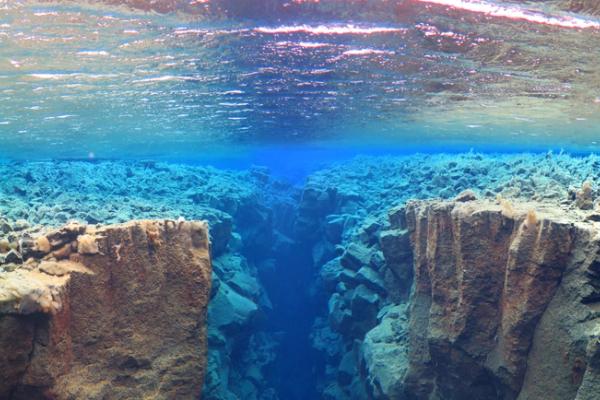
Historical Sites
While exploring Almannagjá, you'll encounter several important historical locations:
- Law Rock (Lögberg) - Though its exact location is debated, a flagpole now marks where scholars believe the Law Rock stood. This was the focal point of the Alþingi assemblies.
- Þingvellir Church - The small white church near the visitor center dates back to 1859, although churches have stood on this site since the adoption of Christianity.
- Prime Minister's Summer House - This modest building by Lake Þingvallavatn has served as a retreat for Iceland's leaders since 1974.
- Drowning Pool (Drekkingarhylur) - A dark chapter in Iceland's history, this pool in the Öxará River was where women convicted of infanticide or adultery were drowned.
Þingvellir Interpretive Center
The modern visitor center houses an exhibition about the park's natural and cultural history. Interactive displays explain tectonic activity, show how the Alþingi functioned, and detail Iceland's journey to independence. Entry costs 1,000 ISK.
The center also provides maps, restrooms, a café, and staff who can answer questions about trail conditions and activities.
Lake Þingvallavatn
Iceland's largest natural lake borders Þingvellir and offers its own attractions. The lake formed in a depression created by the same tectonic forces that shaped Almannagjá, and contains unique fish species that evolved in isolation.
From the eastern edge of Almannagjá, you'll get good views across the lake, especially on clear days when the mountains are reflected in its surface.
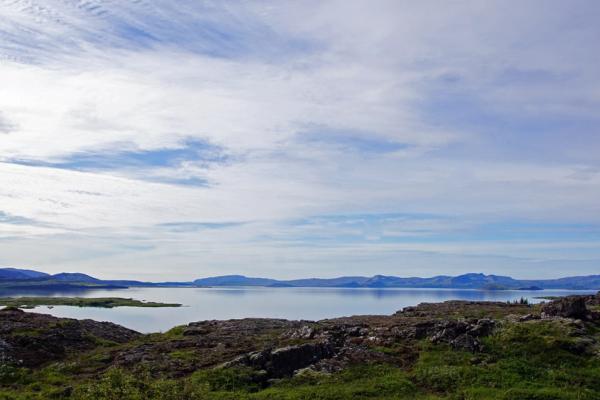
Practical Information for Visitors
Here’s all you need to know to make the most of your visit.
Best Time to Visit
Almannagjá is accessible year-round, but each season offers a different experience:
- Summer (June-August): The most popular time to visit, with long daylight hours (up to 24 hours in June), warmer temperatures (10-15°C/50-59°F), and all facilities open. This is also the busiest period.
- Fall (September-October): Fewer crowds, fall colors, and still decent weather, though with increasing chances of rain.
- Winter (November-March): Short daylight hours and cold temperatures, but the gorge looks different when covered with snow. Some paths may be icy, so proper footwear is essential.
- Spring (April-May): The landscape shows new growth, and visitor numbers are lower than in summer. The weather can be unpredictable.
For the best lighting for photography, early morning or late afternoon provides shadows on the cliff faces.
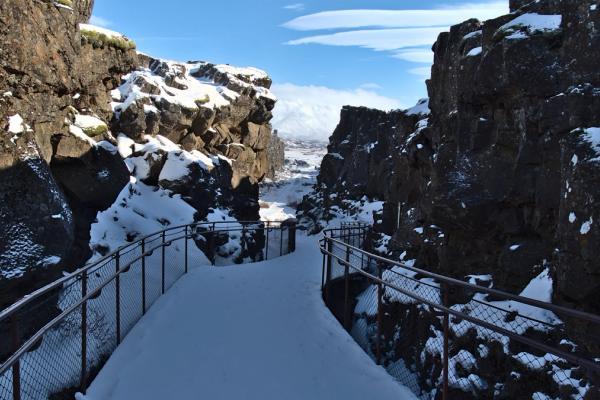
Costs
- Park Entry: Free
- Parking: 1,000 ISK (about $7 USD)
- Visitor Center: 1,000 ISK
- Silfra Snorkeling: From 15,000 ISK ($110 USD)
- Silfra Diving: From 40,000 ISK ($290 USD)
- Guided Walking Tours: From 5,000 ISK ($37 USD)
Safety Tips
- Wear sturdy, waterproof shoes: paths can be uneven and sometimes muddy
- Dress in layers: Icelandic weather changes quickly, even in summer
- Stay on marked paths to protect the ecosystem and for your safety
- Be careful near cliff edges, especially in windy conditions
- If visiting in winter, check trail conditions at the visitor center before setting out
Planning Your Visit
Most visitors spend 2-3 hours exploring Almannagjá and the main sights of Þingvellir. If you're diving or snorkeling at Silfra, add another 2-3 hours.
Almannagjá is typically the first stop on the Golden Circle route, followed by Geysir and Gullfoss Waterfall. To avoid the biggest crowds (especially in summer), try to arrive early in the morning or late in the afternoon.
If you're planning to do a Golden Circle self-drive tour, consider staying overnight in the area to experience Þingvellir without the day-trippers. Several hotels and guesthouses are located within 15-20 minutes of the park, and the park is home to several campsites.
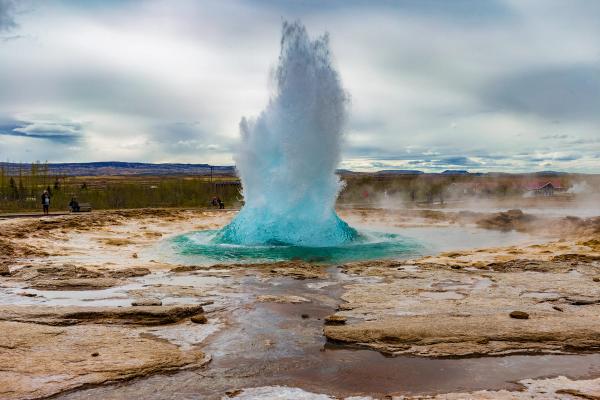
Why is Almannagjá Worth a Visit?
With so many natural sites in Iceland, you might wonder if Almannagjá deserves a spot on your trip plan. Here's why it's worth your time:
- Geological Significance: Few places on Earth offer such a clear view of tectonic forces in action. The visible separation of continental plates makes complex geological processes easier to understand.
- Historical Depth: Walking the same paths as Viking chieftains and standing where crucial decisions shaped a nation provides a connection to the past.
- Accessibility: Unlike some of Iceland's more remote attractions, Almannagjá is easily reached from Reykjavík and suitable for most fitness levels.
- Photographic Opportunities: The combination of cliffs, clear water, and historical sites creates many possibilities for good photos.
- Educational Value: Information boards and the visitor center make this a good place to learn about geology, ecology, and Icelandic history.
- Cultural Context: Understanding Þingvellir and Almannagjá adds depth to your appreciation of Icelandic culture and the sagas that reference this location.
- Pop Culture Connection: Fans of Game of Thrones will recognize Almannagjá as a filming location for the path to the Bloody Gate of the Eyrie in Season 4.
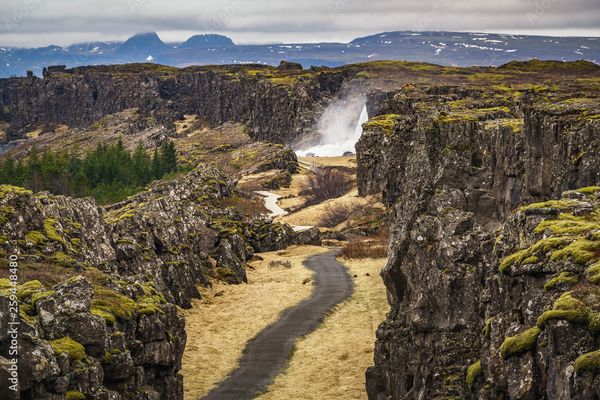
Conclusion
Almannagjá Gorge offers a unique blend of natural wonders and human history. Walking between continental plates while standing where Vikings established one of the world's first parliaments creates an experience that's uniquely Icelandic.

